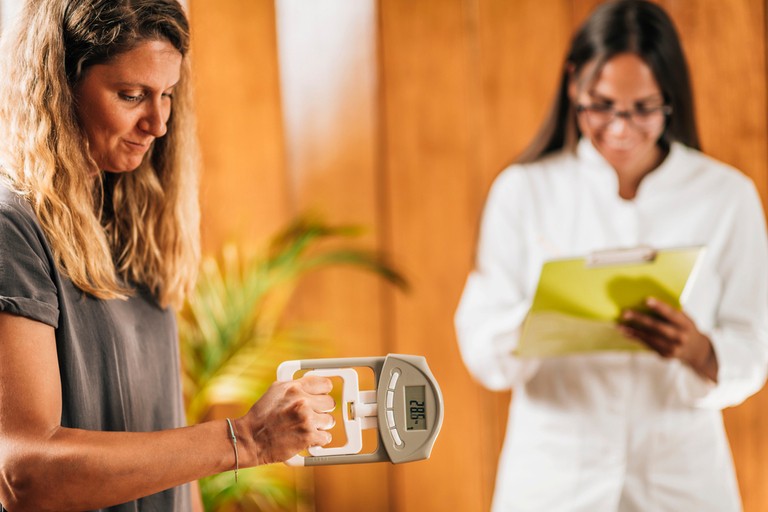Weak forearms, hands, and wrists are very common in both men and women – which impacts a lot on the maximum weight you can lift. To overcome that issue, you will need to increase the muscles on these parts through exercising. Here is how to increase grip strength for weightlifting:
Test Your Grip Strength

Stand on a bench or floor, grasp a pull-up bar with palms facing away from your body.
Feet off the floor or bench and hang from the bar. Remember to keep your shoulders down and your arms extended fully. Hold the position for at least 30 seconds.
If you can’t hold on for that period of time, it is recommended adding in some grip exercises into your repertoire.
Exercises To Increase Grip Strength For Weightlifting
Straight-Arm Hang Exercise

Straight-arm hang helps improve your capability of supporting your bodyweight when you hoist yourself to the top of a pull-up bar or add external loads.
Add this exercise to your routine and do 2-3 sets at least once per week until you can hold on for at least 30 seconds before trying the scapular pull-up.
How to perform it:
Hang from a pull-up bar with shoulder blades down and back, shoulders away from ears, and palms facing away from body. Tighten your core muscles and start with 3 sets of 10-second holds.
Switch To Fat Bar (Or Axle Bar) During Barbell Work
Fat bars are a thicker version of the standard barbell.

If the local gym center doesn’t have an axle bar, you can use a clip-on attachment – called Fat Gripz – to thicken the weight or pull-up bar.
Pinch Plate Curl/Pinch Dumbbell Curl
Hold one 5-pound weight plate in one palm with a pinch grip. Keep your fingers close together and flat against one side while your thumb is wrapped over the edge.
Let your arm hang straight out in front of you, your fingers face toward the floor, and your elbow presses against ribs. This is the starting position.
Slowly curl the plate upwards until it is in front of your shoulders and your thumb facing to your body.
Then, slowly return to the starting position. Do 3 sets of 10 reps on each side. Rest 30 seconds between sets.

Important note: Keep your wrist flexed while exercising. Increase the difficulty level by increasing the plate weight.
Pinch-Grip Carry
Hold two 5-pound weight plates on both hands with fingers flat against one side far from your body and your thumb flat against the opposite side. Keep the weight plates down by your side. That is the starting position.
While keeping that position, start walking until your hands, fingers, and arms feel tired.
To challenge yourself more, increase the plate weight, walk a longer distance, or hold the plate in one hand.
Pinch-Grip Deadlift
Pinch-grip deadlift can either be done as a dynamic exercise or as a static hold.
Set up like you are going to do a T-bar. Place the T-bar on the ground in front of you and you’re standing in the center of the bar as long as your hands can reach each weight plate.

Bend knees as long as they don’t reach over the feet. Pinch two weight plates by your palms. If you’re a beginner, choose lighter weight plates for safety.
Keep your fingers flat against the side far away from your body and your thumb flat against the opposite side. Keep your back flat, neck straight, and chest open. That’s the starting position.
Start lifting the plates by hinging forward at your hips and pushing your bums back. Squeeze glutes at the top and stand up with the plates.
Slowly return to the starting position. Do 2 sets of 10 reps. Rest 30 seconds between reps.
Scapular Pull-Up
Grasp a pull-up bar with arms extended fully and palms facing away from your body. Lift your feet off the ground and hang from the bar.
Raise your body slowly up by tightening your core muscles and squeezing shoulder blades toward each other. Pause here for one second before slowly returning to the starting position.

Do three sets of 10 reps. Rest 30 second between sets.
When Should I See A Physical Therapist?

See a physical therapist for treatment and diagnosis if you experience profound weakness, loss of sensation, or tingling while doing grip exercises. Be mindful of the part where the issue originates.
If the tingling or weakness comes from the thumb side, chances are that it is related to the radial nerve.
If it comes from the pinky side, there might be a problem with the ulnar nerve.
Conclusion
Hopefully, you have already learned how to increase grip strength for weightlifting through this article. I’d like to hear from you more, so if there are any questions, please let me know in the comment section.
Don’t forget to visit my blogs for more helpful guides. Thanks for reading!








